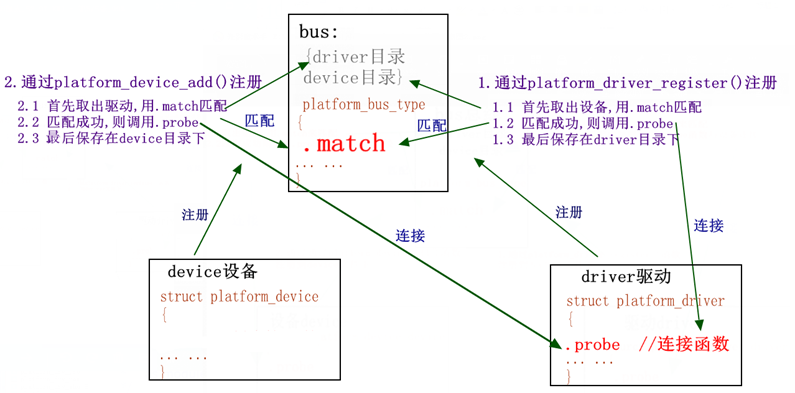学习目标: 学习实现platform机制的分层分离,并基于platform机制,编写led设备和驱动程序;
一、分离分层
输入子系统、usb设备比驱动以及platform类型的驱动等都体现出分离分层机制;如下图所示,一种典型的分离分层框架:

二、platform机制下的分离
分离就是在驱动层中使用platform机制把硬件相关的代码(固定的,如板子的网卡、中断地址)和驱动(会根据程序作变动,如点哪一个灯)分离开来,即要编写两个文件:dev.c和drv.c(platform设备和platform驱动)。
会在开发板/sys/bus/platform目录下出现这两个文件,并且在两个文件目录下存在命名相同的设备和驱动程序。

同样的,在/sys/bus/i2c等其它的总线类型目录下,也存在设备和驱动各自的目录。
platform总线:为platform_bus_type,是个全局变量,属于虚拟设备总线, 属于Linux中bus的一种:
1 struct bus_type platform_bus_type = { 2 .name = "platform", 3 .dev_attrs = platform_dev_attrs, 4 .match = platform_match, 5 .uevent = platform_uevent, 6 .suspend = platform_suspend, 7 .suspend_late = platform_suspend_late, 8 .resume_early = platform_resume_early, 9 .resume = platform_resume, 10 };
利用该设备总线,一旦一方注册就会调用.match函数进行匹配,将driver和device连接在一起,匹配成功后会调用driver程序里的.probe函数:

其中,device设备为挂接在platform总线下的设备, platform_device结构体类型,driver驱动为挂接在platform总线下,与某种设备相关的驱动程序, platform_driver结构体类型。
三、例程--基于platform机制,编写led设备和驱动程序
需要分别编写设备代码和驱动代码: led_dev.c 、led_drv.c。其中,
led_dev.c:指定设备硬件/寄存器资源。
led_drv.c:获取设备资源,初始化并操作led。
3.1 led_drv.c
1 /* 分配/设置/注册一个platform_driver */ 3 #include <linux/module.h> 4 #include <linux/version.h> 6 #include <linux/init.h> 7 #include <linux/fs.h> 8 #include <linux/interrupt.h> 9 #include <linux/irq.h> 10 #include <linux/sched.h> 11 #include <linux/pm.h> 12 #include <linux/sysctl.h> 13 #include <linux/proc_fs.h> 14 #include <linux/delay.h> 15 #include <linux/platform_device.h> 16 #include <linux/input.h> 17 #include <linux/irq.h> 18 #include <asm/uaccess.h> 19 #include <asm/io.h> 20 21 static int major; 24 static struct class *cls; 25 static volatile unsigned long *gpio_con; 26 static volatile unsigned long *gpio_dat; 27 static int pin; 28 29 static int led_open(struct inode *inode, struct file *file) 30 { 31 /* 配置为输出 */ 32 *gpio_con &= ~(0x3<<(pin*2)); 33 *gpio_con |= (0x1<<(pin*2)); 34 return 0; 35 } 37 static ssize_t led_write(struct file *file, const char __user *buf, size_t count, loff_t * ppos) 38 { 39 int val; 41 copy_from_user(&val, buf, count); // copy_to_user(); 42 43 if (val == 1) 44 { 45 // 点灯 46 *gpio_dat &= ~(1<<pin); 47 } 48 else 49 { 50 // 灭灯 51 *gpio_dat |= (1<<pin); 52 } 54 return 0; 55 } 58 static struct file_operations led_fops = { 59 .owner = THIS_MODULE, /* 这是一个宏,推向编译模块时自动创建的__this_module变量 */ 60 .open = led_open, 61 .write = led_write, 62 }; 63 64 /* 2.1 当驱动和设备都insmod加载后,然后bus总线会匹配成功,就进入.probe函数, 65 2.2 在.probe函数中便使用platform_get_resource()函数获取LED的地址和引脚,然后初始化LED,并注册字符设备,和设备节点"led", 66 2.3 编写注册时的file_operations成员函数 67 */ 68 static int led_probe(struct platform_device *pdev) 69 { 70 struct resource *res; 71 72 /* 根据platform_device的资源进行ioremap */ 73 res = platform_get_resource(pdev, IORESOURCE_MEM, 0); //IORESOURCE_MEM资源中的第0个 74 gpio_con = ioremap(res->start, res->end - res->start + 1); 75 gpio_dat = gpio_con + 1; //指针加1==》相当于+4 76 77 res = platform_get_resource(pdev, IORESOURCE_IRQ, 0); //IORESOURCE_IRQ资源中的第0个 78 pin = res->start; 79 80 /* 注册字符设备驱动程序 */ 82 printk("led_probe, found led "); 83 84 major = register_chrdev(0, "myled", &led_fops); 85 86 cls = class_create(THIS_MODULE, "myled"); 87 88 class_device_create(cls, NULL, MKDEV(major, 0), NULL, "led"); /* /dev/led */ 89 90 return 0; 91 } 93 static int led_remove(struct platform_device *pdev) 94 { 95 /* 卸载字符设备驱动程序 */ 96 /* iounmap */ 97 printk("led_remove, remove led "); 98 99 class_device_destroy(cls, MKDEV(major, 0)); 100 class_destroy(cls); 101 unregister_chrdev(major, "myled"); 102 iounmap(gpio_con); 103 104 return 0; 105 } 108 struct platform_driver led_drv = { 109 .probe = led_probe, 110 .remove = led_remove, 111 .driver = { 112 .name = "myled", 113 } 114 }; 115 116 /*1. 注册的led驱动*/ 117 static int led_drv_init(void) 118 { 119 platform_driver_register(&led_drv); 120 return 0; 121 } 123 static void led_drv_exit(void) 124 { 125 platform_driver_unregister(&led_drv); 126 } 128 module_init(led_drv_init); 129 module_exit(led_drv_exit); 131 MODULE_LICENSE("GPL");
其中, platform_get_resource函数为:
struct resource * platform_get_resource(struct platform_device *dev, unsigned int type,unsigned int num); //获取设备的某个资源,获取成功,则返回一个resource资源结构体 //参数: // *dev: 指向某个platform device设备 // type: 获取的资源类型 // num: type资源下的第几个数组
platform_driver结构体:
struct platform_driver { int (*probe)(struct platform_device *); int (*remove)(struct platform_device *); void (*shutdown)(struct platform_device *); //断电 int (*suspend)(struct platform_device *, pm_message_t state); //休眠 int (*suspend_late)(struct platform_device *, pm_message_t state); int (*resume_early)(struct platform_device *); int (*resume)(struct platform_device *); //唤醒 struct device_driver driver; //内嵌的driver, 主要是name成员:设备的名称 };
3.2 led_dev.c
1 #include <linux/module.h> 2 #include <linux/version.h> 3 #include <linux/init.h> 4 #include <linux/kernel.h> 5 #include <linux/types.h> 6 /* 分配/设置/注册一个platform_device */ 7 #include <linux/interrupt.h> 8 #include <linux/list.h> 9 #include <linux/timer.h> 10 #include <linux/init.h> 11 #include <linux/serial_core.h> 12 #include <linux/platform_device.h> 13 14 static struct resource led_resource[] = { 15 [0] = { 16 .start = 0x56000050, //寄存器的起始物理地址 GPFCON 0x56000050 17 .end = 0x56000050 + 8 - 1, 18 .flags = IORESOURCE_MEM, //哪一类资源 19 }, 20 [1] = { 21 .start = 5, //哪(位)个引脚 22 .end = 5, 23 .flags = IORESOURCE_IRQ, 24 } 25 26 }; 27 28 static void led_release(struct device * dev) 29 { 30 } 32 static struct platform_device led_dev = { 33 .name = "myled", 34 .id = -1, //表示只有一个设备 35 .num_resources = ARRAY_SIZE(led_resource),//资源数量,ARRAY_SIZE()函数:获取数量 36 .resource = led_resource, 37 .dev = { 38 .release = led_release, 39 }, 40 }; 41 42 static int led_dev_init(void) 43 { 44 platform_device_register(&led_dev); 45 return 0; 46 } 47 48 static void led_dev_exit(void) 49 { 50 platform_device_unregister(&led_dev); 51 } 52 module_init(led_dev_init); 53 module_exit(led_dev_exit); 54 MODULE_LICENSE("GPL");
其中,platform_driver结构体:
struct platform_device { const char * name; //设备名称,要与platform_driver的name一样,这样总线才能匹配成功 u32 id; //id号,插入总线下相同name的设备编号(一个驱动可以有多个设备),如果只有一个设备填-1 struct device dev; //内嵌的具体的device结构体,其中成员platform_data,是个void *类型,可以给平台driver提供各种数据(比如:GPIO引脚等等) u32 num_resources; //资源数量, struct resource * resource; //资源结构体,保存设备的信息 };
struct resource { resource_size_t start; //起始资源,如果是地址的话,必须是物理地址 resource_size_t end; //结束资源,如果是地址的话,必须是物理地址 const char *name; //资源名 unsigned long flags; //资源的标志 //比如IORESOURCE_MEM,表示地址资源, IORESOURCE_IRQ表示中断引脚... ... struct resource *parent, *sibling, *child; //资源拓扑指针父、兄、子,可以构成链表 };
3.3 测试程序
1 #include <sys/types.h> 2 #include <sys/stat.h> 3 #include <fcntl.h> 4 #include <stdio.h> 5 6 /* led_test on 7 * led_test off 8 */ 9 int main(int argc, char **argv) 10 { 11 int fd; 12 int val = 1; 13 fd = open("/dev/led", O_RDWR); 14 if (fd < 0) 15 { 16 printf("can't open! "); 17 } 18 if (argc != 2) 19 { 20 printf("Usage : "); 21 printf("%s <on|off> ", argv[0]); 22 return 0; 23 } 24 25 if (strcmp(argv[1], "on") == 0) 26 { 27 val = 1; 28 } 29 else 30 { 31 val = 0; 32 } 34 write(fd, &val, 4); 35 return 0; 36 }
1)将led_dev和led_drv编译为模块,加载。会在sys/bus/platform/devices目录下分别生成一个"myled"。
2)最后,编译应用程序,并在开发板运行可执行程序,控制led:
# led_test on
# led_test off